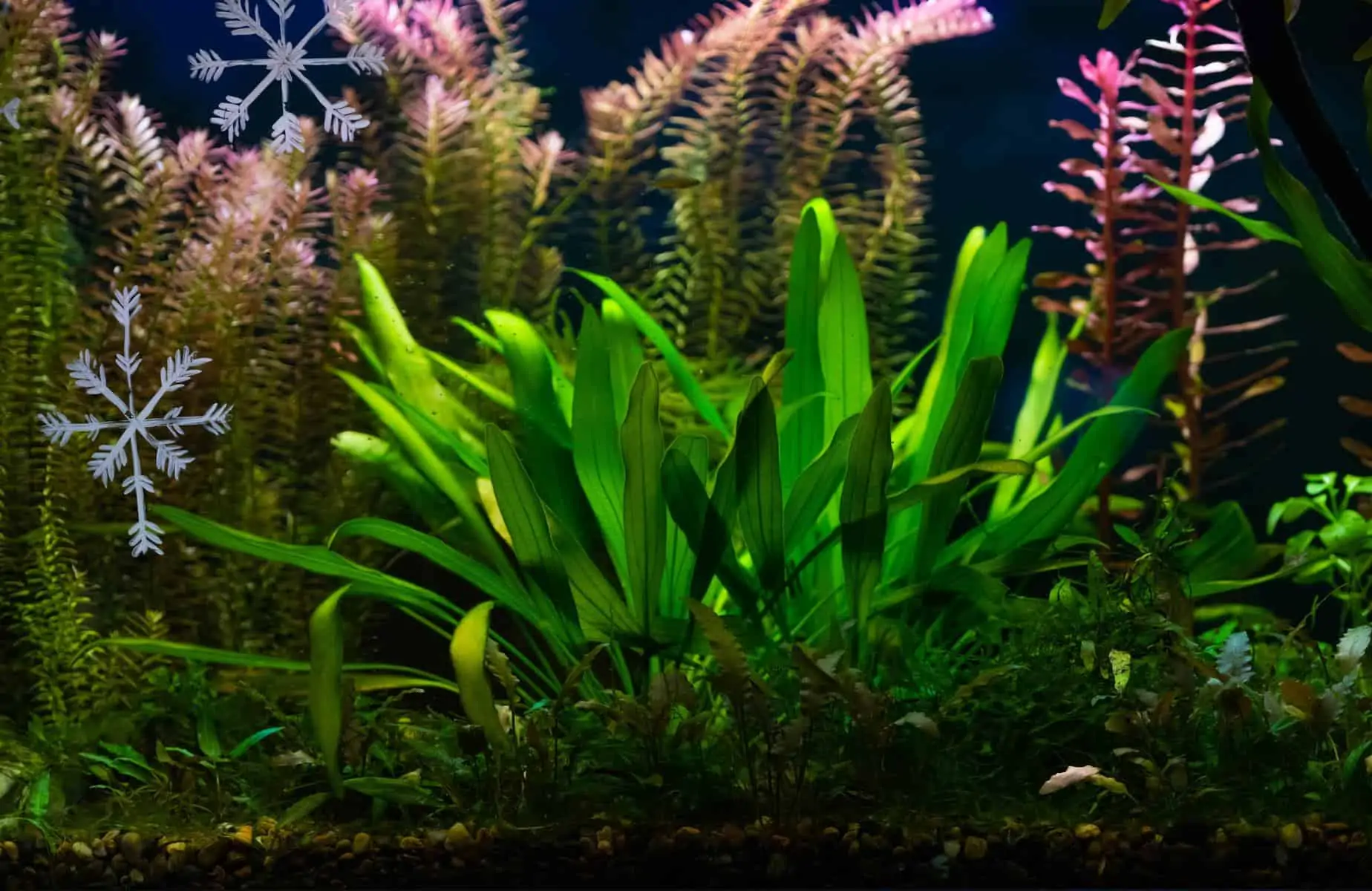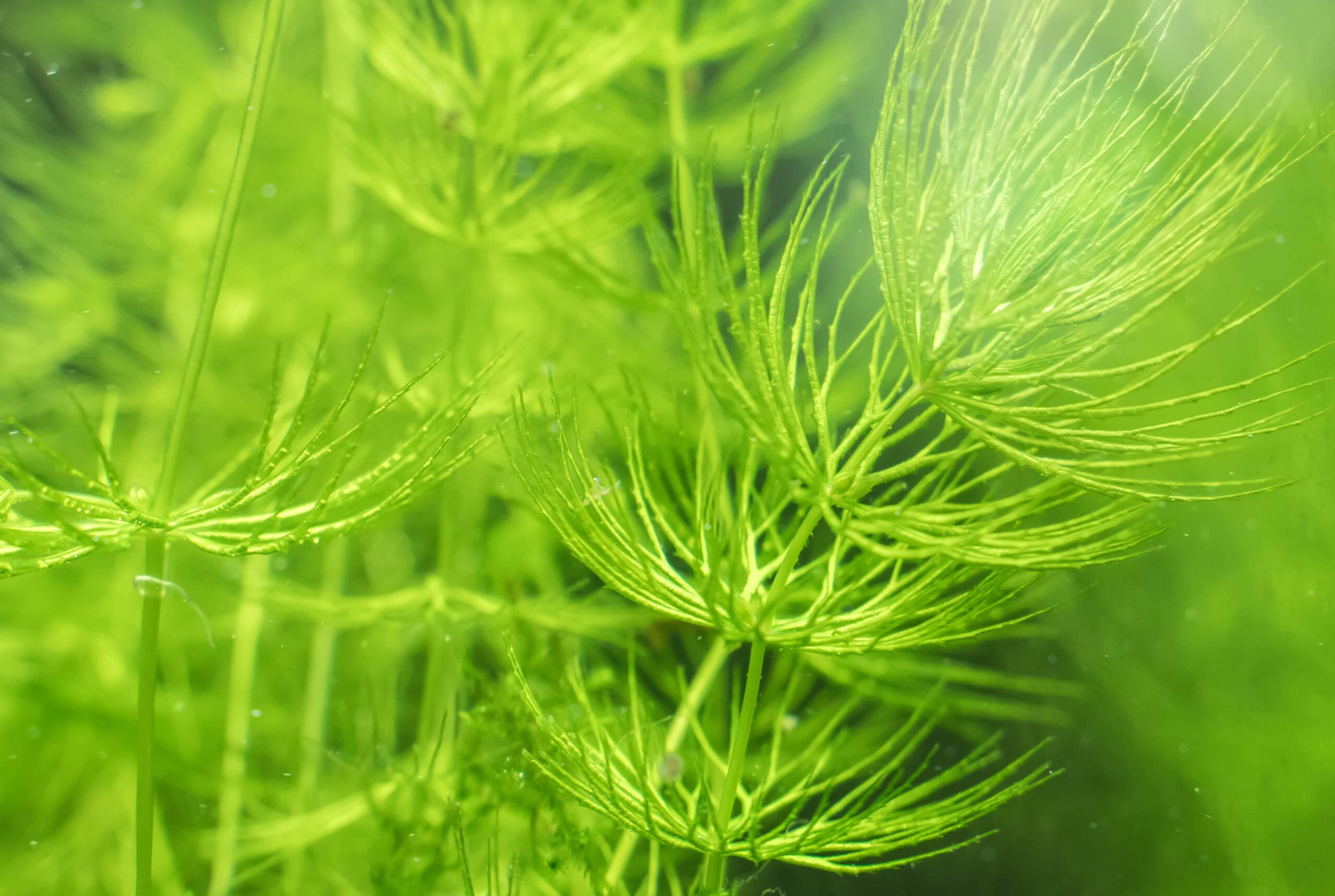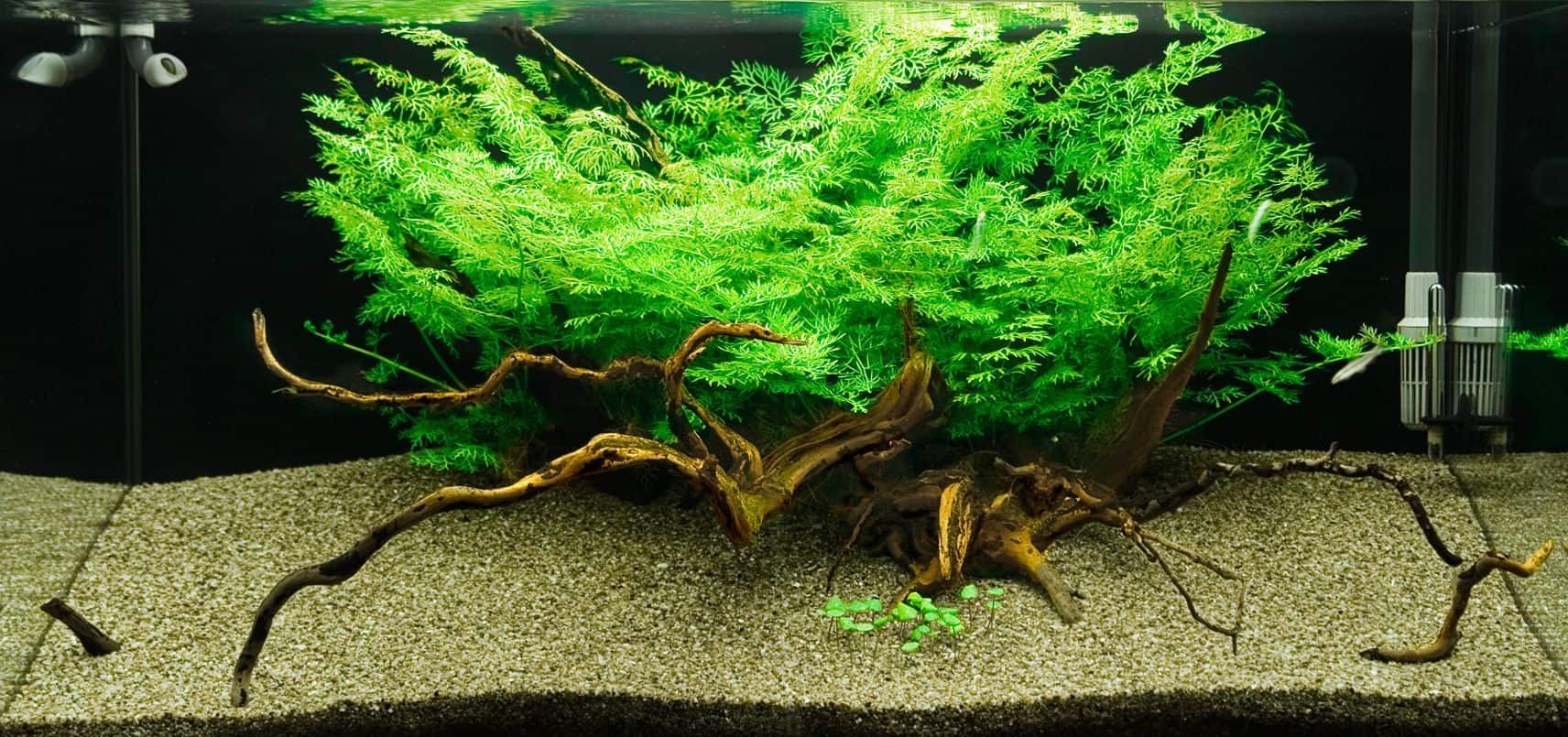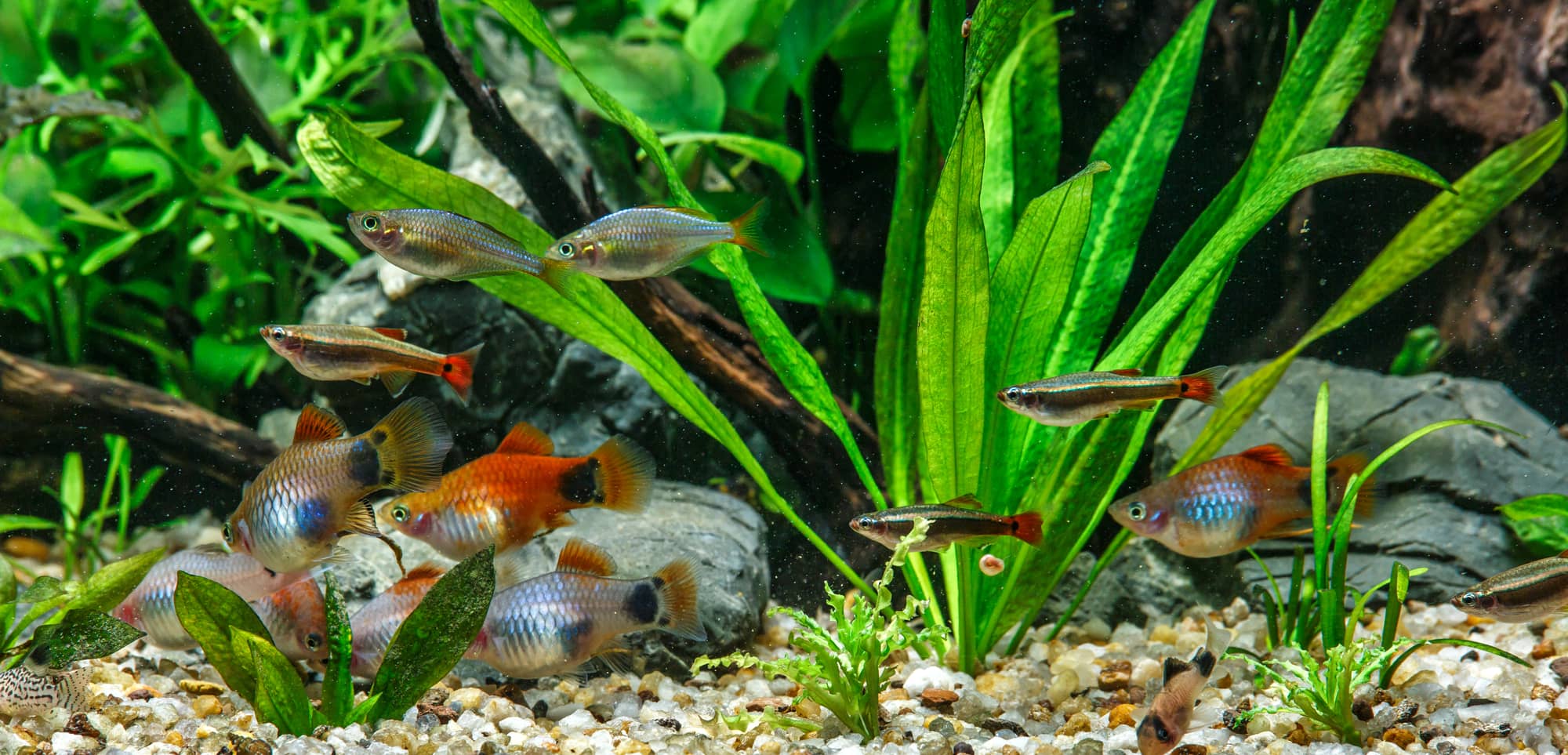Aquatic plants are an extremely important addition to any freshwater fish tank. In return for a little simple maintenance, plants bring color and beauty to the underwater environment. They also add value by helping to oxygenate the water, taking up harmful nitrates, and providing plenty of hiding spots for shy fish and vulnerable fry.
Beginners are often put off keeping living plants, assuming they’re difficult to care for. Although some species are indeed more challenging to keep than others, we’ve found ten ideal beginner plants. These species stand out for their resilience and simplicity of care, and they look great, too!
Keep reading to discover ten perfect aquarium plants for beginners!
Key Takeaways
- Incorporating aquatic plants like the suggested ten varieties can beautify an aquarium while improving water quality and creating natural hideaways for fish, with minimal upkeep required.
- All our highlighted plants, including Java Fern, Java Moss, and Anubias, are hardy and resilient, adaptable to various lighting conditions, and don’t need complex care routines, making them ideal for novices.
- These plants offer simple propagation techniques, such as cutting rhizomes or planting baby plants, allowing aquarium enthusiasts to multiply their greenery effectively and economically.
Summary Table
| Common Name | Scientific Name | Preferred Water Temperature | Growth Habit | Size | Average Cost |
|---|---|---|---|---|---|
| Java Fern | Microsorum pteropus | 68-82°F (20-28°C) | Attached to driftwood/rocks | Up to 13.5 inches | $4-$10 |
| Anubias | Anubias spp. | 72-82°F (22-28°C) | Rooted or attached | 5-10 inches | $5-$15 |
| Cryptocoryne | Cryptocoryne spp. | 72-82°F (22-28°C) | Rooted | 2-18 inches | $5-$20 |
| Amazon Sword | Echinodorus spp. | 72-82°F (22-28°C) | Rooted | Up to 20 inches | $5-$15 |
| Hornwort | Ceratophyllum demersum | 59-86°F (15-30°C) | Floating or anchored | Up to 10 feet | $2-$5 per bunch |
| Java Moss | Taxiphyllum barbieri | 70-75°F (21-24°C) | Attached or floating | Indefinite | $5-$10 per portion |
| Water Wisteria | Hygrophila difformis | 74-82°F (23-28°C) | Rooted | 10-20 inches | $3-$7 |
| Water Sprite | Ceratopteris thalictroides | 68-82°F (20-28°C) | Floating or rooted | 6-8 inches | $3-$6 |
| Duckweed | Lemna minor | 50-86°F (10-30°C) | Floating | 0.02-0.2 inches | $2-$5 per cup |
| Vallisneria | Vallisneria spp. | 72-82°F (22-28°C) | Rooted, with runners | Up to 6 feet | $5-$10 per bunch |
*Please note that the sizes are averages and can vary depending on the specific conditions within your aquarium. The average cost can vary widely depending on your region, the source of the plant, and its size or growth stage at the time of purchase.
Java Fern (Microsorum pteropus)

Java Fern is native to the tropical regions of Southeast Asia, where it thrives along the shaded banks of slow-moving streams and rivers. This popular, easy-care plant has dark green, leathery leaves that add an elegant touch to any tank as they sway gently in the current.
Java fern prefers low to moderate light and can be attached to driftwood or rocks with fishing lines or twine, making it a favorite among aquarists seeking easy yet striking foliage. You can propagate the plant in three different ways:
- Separate the plant at the rhizome, using a sharp pair of scissors or a knife to cut the rhizome into sections, making sure each section has a few leaves attached. Plant each section in the substrate or attach it to a piece of rock or wood in the aquarium.
- Java fern occasionally produces small plantlets on the underside of its leaves. Gently twist a plantlet off the leaf and plant it in the substrate where you want it to grow. The tiny plant will put out roots and grow pretty quickly in its new location.
- Java fern can also be propagated from spores, although this method is more challenging and time-consuming. You collect the spores from the underside of a mature plant’s leaves and put them in a container with water, then wait for them to germinate. Once the spores have germinated, you can plant them in the substrate or attach them to rock or wood.
Anubias (Anubias spp.)

Anubias originates from the riverbanks and marshes of Africa and is an excellent exotic plant choice for newbies to the hobby.
With its broad, dark green leaves and sturdy rhizome structure, all varieties of Anubias are pretty hardy and require minimal care. The plant thrives in low to moderate light, rooted in the substrate or attached to hardscape elements in your tank. Anubias does best in low to moderate light, doesn’t need additional supplementation, and provides an attractive refuge for your aquarium’s aquatic inhabitants.
You can propagate Anubias in several ways.
- Use a sharp pair of scissors or a knife to cut the rhizome into small pieces, ensuring each section has a few leaves attached. You can choose to attach the sections to a piece of rock or wood in the aquarium or plant them into the substrate. Make sure you plant the rhizome above the substrate, as burying it can cause it to rot.
- Anubias can also be propagated by cutting off a leaf with a healthy root attached and planting it in the substrate, making sure the root is buried.
- Some Anubias varieties produce small plantlets on the underside of their leaves. Simply plant the plantlet in the substrate in your desired location.
Be gentle when handling the plants so you don’t damage the rhizome or roots. With a little patience and care, your Anubias should propagate easily and provide you with plenty of new plants to add to your aquarium.
Cryptocoryne (Cryptocoryne spp.)

Crytopcoryne is found in Asia’s lush rainforests and marshy areas, where it grows in shallow streams and ponds.
Crypto has broad leaves in shades of green, red, or brown, adding a gorgeous splash of color and texture to aquariums. This versatile tropical plant prefers low to moderate light, making it ideal for a standard tank setup. The plant grows best when provided with a little additional supplementation.
You can propagate all varieties of Cryptocoryne through division or by planting the offshoots it produces.
- When your Crypto plant has grown large enough, you can carefully remove it from the substrate. Gently separate the roots and rhizome into smaller sections, ensuring each has both roots and leaves. Plant these divisions back into the substrate.
- Cryptocoryne plants often produce runners or daughter plants, which are effectively mini versions of the parent plant attached by a runner. When the offshoots have developed their own root system and a few leaves, you can carefully detach them from the parent plant and replant them in the substrate.
Amazon Sword (Echinodorus spp.)

This plant is native to the waterways of Central and South America and is a favorite with many aquarists. Although it’s a tropical plant, I’ve grown it successfully with goldfish in a cold water setup. Since goldfish tend to uproot and destroy aquatic plants, the fact this species did so well is a testament to its resilience!
Amazon Sword plants have long, sword-shaped leaves that reach towards the light, hence their the species’ common name. The plant grows in dense stands along the banks of rivers and lakes, where it provides welcome shelter for fish and other aquatic creatures.
Although this species prefers moderate to high light and benefits from supplementation with root tabs, this hardy plant grows to an impressive size in your tank. Therefore, this plant does best in a large tank with plenty of space to grow.
You can propagate Amazon Sword in a couple of ways:
- When the plant is mature, take it out of the substrate and separate the roots and rhizome into small sections with both leaves and roots. Replant the sections in the substrate.
- Amazon Swords often produce plantlets on their flower stalks, which develop roots while still attached to the parent plant. Once the roots are visible, detach the plantlet and replant it in the substrate.
Avoid disturbing the plants excessively after replanting to allow them to establish themselves effectively.
Hornwort (Ceratophyllum demersum)

Hornwort is found in freshwater ecosystems worldwide, thriving in ponds, lakes, and slow-moving streams.
The plant has fine, bushy foliage and grows incredibly quickly, making it a favorite among experienced and beginner hobbyists alike. You can grow Hornwort free-floating as a surface plant or anchored in the substrate since it grows equally well in high or low-light environments.
You can propagate Hornwort easily in two ways:
- Break off pieces of the stem and replant them in your aquarium substrate. Note that each fragment needs a few leaves and some of the stem intact.
- Alternatively, simply allow the plant to float freely in your tank. Eventually, the plant will produce new shoots and roots from the nodes along its stem. Once established, separate the growth from the main plant and plant them into the substrate.
Regular pruning is essential for this fast-growing plant to prevent overcrowding and maintain the shape you want.
Java Moss (Taxiphyllum barbieri)

This plant comes from Southeast Asia’s thick, shady forests, where it carpets rocks and fallen branches along the banks of streams and rivers. Java Moss’s bushy growth habit and vibrant green color make it a popular choice for aquascaping enthusiasts.
Even better, the plant needs minimal care, thrives in low light conditions, and doesn’t require additional supplementation to thrive.
Propagating Java Moss is quite straightforward.
- You can propagate Java Moss by simply dividing the existing plant into smaller portions and gently pulling it into smaller clumps. Each clump should have some healthy moss strands attached to it.
- Use a short length of fishing line or cotton thread to attach the portions of Java Moss to driftwood, rocks, or mesh pads. Once attached, the plant will continue to grow and spread over the surface until the entire area is covered.
Regularly trim your Java Moss with scissors to control its size and prevent it from becoming too dense.
Water Wisteria (Hygrophila difformis)
This charming plant is native to the marshes and floodplains of India and Southeast Asia, where it grows in shallow streams and ponds.
Water Wisteria’s delicate, fern-like leaves and dense growth habit bring elegance to the aquarium. This beautiful plant provides the perfect hiding place for shy fish and fry and is surprisingly easy to grow in moderate light without needing supplements.
You can propagate Water Wisteria in your aquarium in several ways:
- Use sharp scissors or pruning shears to cut a healthy stem from the parent plant. The stem should be at least 3 to 4 inches long with several leaves attached. Remove the bottom leaves, and plant the stem in the substrate, where it will quickly become established.
- If the plant is large enough, you can divide it into smaller plants. Take the plant from the substrate and gently separate the roots into smaller sections with a few stems and leaves attached. Plant each section in the substrate.
Water Sprite (Ceratopteris thalictroides)

Water Sprite is a versatile plant found in freshwater habitats worldwide, from Asia to Africa and the Americas.
With its finely divided, feathery leaves and rapid growth habit, this plant provides excellent cover for fish and fry. Whether you leave it to float on the water’s surface or plant it in the substrate, the adaptable Water Sprite plant does equally well in low to moderate light conditions.
You can propagate Water Sprite in a couple of ways:
- To propagate through division, carefully remove the plant from the substrate and divide it into smaller sections, each with a few leaves and a healthy root system. Plant each section in the substrate or attach it to a piece of rock or wood.
- Remove plantlets from the parent plant. Ensure each baby plant has an established root system and plant it in the substrate.
Duckweed (Lemna minor)

Duckweed grows rapidly in ponds, lakes, and slow-moving rivers worldwide, often spreading to cover the entire water’s surface.
Thanks to its rapid reproduction rate and ability to absorb excess nutrients from the water, duckweed is an extremely valuable and popular addition to any fish tank. It needs very little care, thriving in low to moderate light and needing no supportive supplementation.
You don’t need to worry about propagating this plant! Duckweed spreads incredibly rapidly through division. You’ll need to be prepared to thin out and remove quite a lot of it to prevent the plant from taking over your tank. For that reason, this plant is recommended for larger setups only, as it will quickly choke a small tank if allowed to grow unchecked.
Vallisneria (Vallisneria spp.)

Vallisneria grows in many temperate and tropical regions worldwide and is a popular aquarium plant prized for its long, ribbon-like leaves and graceful swaying motion.
This elegant yet hardy plant prefers moderate to low light conditions and gets most of its nutrition from the water column and photosynthesis.
Vallisneria propagates primarily through runners that grow along the substrate. Nodes along the runners develop into new plantlets, which can be left attached to the mother plant until they have developed roots and can be separated. Once the plantlets have developed roots, gently separate them from the mother plant and replant them in the substrate.
Final Thoughts
You can have a beautifully aquascaped aquarium, even if you’re not an expert horticulturist, by choosing some of the plant varieties we’ve featured in this guide!
All these plants are easy to grow, maintain, and propagate, and none need specialist lighting or fancy supplementation to thrive. Simply remove dead leaves, trim overgrowth, and thin out the plants when necessary, and you’ll be rewarded with healthy plants, a gorgeous aquascape to gaze at, and happy fish!


